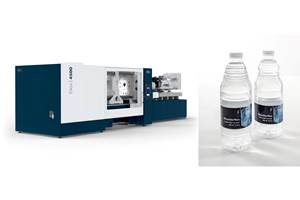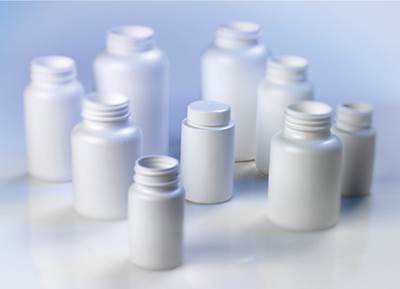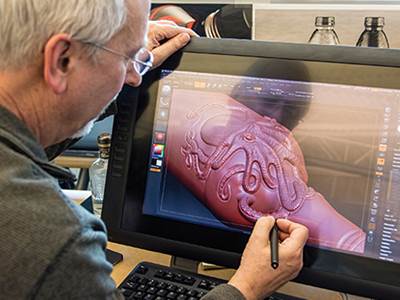Compression Blow Forming: Promising New Process
‘Game-changing’ technology is overcoming initial growing pains with a new generation of machines.
Willingness to invest in brand-new and potentially “game-changing” process technologies is one aspect of the strong emphasis on R&D at , Ann
Arbor, Mich. As reported in last month’s profile of the company, one of the firm’s pioneering projects is Compression Blow Forming, which Amcor was the first to put into commercial production in 2012. A recent conversation with Tod Eberle, v.p. of Quality Systems, Engineering Standards, and Advanced New Platform Technologies, provided an update on where this technology stands today and on progress toward realizing its promise of superior quality, productivity, and sustainability.
PHARMA BOTTLES BENEFIT
Compression Blow Forming (CBF) technology evolved from continuous compression molding of caps and closures by of Italy (see July’12 Close Up). CBF involves continuous extrusion of a “hockey puck,” which is compression molded into a preform
and then stretch-blown in a system of interlocking wheels. Amcor has three 12-cavity CBF machines in Youngsville, N.C., making stock and custom HDPE pharmaceutical bottles for two large producers of generics and supplements.
Eberle has no doubt that CBF will prove to be a game changer. It has demonstrated energy savings of 30-35% compared with the injection-blow molding (IBM) process normally used for pharma bottles. “Customers like the sustainability benefit,” Eberle notes. CBF also offers higher productivity—up to 6000 bottles/hr—with higher rates on the horizon. “Dramatically” tighter weight control is another benefit. For a typical IBM
bottle-weight specification of ± 0.7-0.8 g, CBF achieves a Cpk of 10, which is “unheard of” in IBM, says Eberle. He also likes the extremely low scrap generation on startup and shutdown—“the lowest of any polyolefin process I’ve seen.”
Amcor set specific goals for the process: performance to nameplate capacity of 85% or better and manufacturing efficiency (uptime) greater than 90%. Both have been realized, he says, with some qualifications.
ADDRESSING WEAR ISSUES
As with any brand-new process, not to mention one as sophisticated and complex as this, there have been growing pains. “The primary long-term issue has been premature wear of the aluminum blow molds,” Eberle acknowledges. “We’re cutting IBM cycle times by around half, so we need fast-cooling aluminum molds. But aluminum tends to be soft, which leads to parting-line wear and visual defects in bottles. Unfortunately,
pharma customers are used to perfect parting lines from IBM.”
The second major concern has been wear on the rotary union that distributes air, hydraulic fluid, and cooling medium at two different temperatures. Eberle is quick to note that “Sacmi has been world-class in working with us to address these issues.” He is pleased that Sacmi supplemented its spare parts facility in Des Moines, Iowa, last year with a , giving it added presence in North America.
Eberle says there has been steady progress in improving the mold engineering. The next-generation machine, now being tested by Sacmi, uses a clamshell closing arrangement in place of the parallel closing used to date. This is expected to be gentler to the molds. “We’re targeting a three-year refurbishment life for blow molds, but we’ll need more time to prove it.”
The new machines have 16 to 20 cavities and also provide 8-15% shorter dry-cycle time, promising significant productivity enhancement. Like the first-generation systems, these are servo-electric/hydraulic hybrids, but Sacmi is well along in developing an all-electric version that may debut in 2017.
The upshot from three years of production experience is that CBF makes good sense for dedicated production of high-volume products, Eberle concludes. Changing over compression and blow tooling, and perhaps the extrusion nozzle and downstream handling, is more complex and time-consuming than for IBM. “We’ll reserve IBM for frequent-changeover, shorter runs.”
Related Content
Krones Acquires Netstal
Krones adds PET preform injection molding to its bottle blowing and filling capabilities, as well as cap molding and expansion into medical, food and other markets.
Read MoreDigital Manufacturing: Two Medical Molders Embrace Industry 4.0
‘Digitalization’ and ‘connectivity’ are loaded terms—shorthand for a whole new way of doing ´óĎó´«Ă˝. It can’t be accomplished in one go. But two Midwest molders in the sensitive medical field are already feeling the benefits of their initial steps in that direction.
Read MoreMedical and Molding Elite
When Jeff Smith received a notice evicting his promising ´óĎó´«Ă˝ out of his house, it could have been the end of Elite Biomedical Solutions’ and Elite Precision Plastics’ stories before they really got started, instead it was just the beginning.
Read MoreAllegheny Performance Plastics to Enter Health Care Sector
The custom molder has secured multiple projects in health care and will be adding cleanroom and white-room spaces, as well as injection molding machines, in support.
Read MoreRead Next
Compression Blow Forming Process in Commercial Production
Expectations of higher productivity, improved quality, and energy savings for a novel blow molding process are now being realized in commercial production at Amcor Rigid Plastics in Youngsville, N.C.
Read MoreDeveloping Tomorrow’s Containers: Inside Amcor’s R&D Center
How award-winning package design, full-service laboratory facilities, and game-changing process development support a world-class injection and blow molder.
Read MoreSee Recyclers Close the Loop on Trade Show Production Scrap at NPE2024
A collaboration between show organizer PLASTICS, recycler CPR and size reduction experts WEIMA and Conair recovered and recycled all production scrap at NPE2024.
Read More











